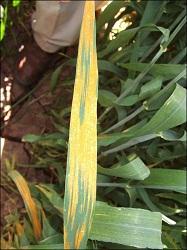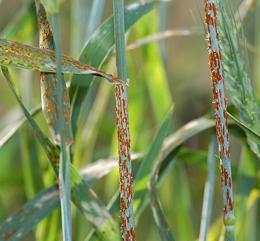Using AI to control energy for indoor agriculture
30 September 2024
Published online 20 July 2011

Wheat rust, a fungus that affects different parts of wheat, threatens to destroy over 20% of wheat yield every year, mainly in Africa and Asia. Efforts to control the fungus often come down to an evolutionary race, as researchers try to breed new disease resistant varieties of wheat faster than the fungus can evolve and break the resistance.
Epidemics of wheat rust are frequent. Since last year, an outbreak of yellow wheat rust emerged in Syria with some estimates claiming that wheat rust destroyed between 20—50% of Syria's wheat yield in 2010.
Mahmoud Solh, director of the International Center for Agriculutral Research in the Dry Areas (ICARDA), based in Aleppo, Syria, spoke to Nature Middle East about the set of challenges the various strains pose to the region and what steps researchers should take to help control the crop disease.
Rust is a major threat to wheat production. And in this part of the world it is a major staple crop. The average per capita consumption of wheat in the Arab world is around 180kg/person per year, which is really high. Some countries like Morocco go up to 230kg/person per year. This covers not only bread, but other products so it is really between the bread wheat and the durum wheat.
Wheat black stem rust, out of which a new strain of black stem rust called Ug99 emerged and was identified in Uganda during the 1998/1999 growing season, is a more serious threat than yellow rust because it will kill the whole plant completely (rather than infecting parts of it). But fortunately so far — and I want to underline so far — our environment is not very conducive for Ug99. In 2001, it moved from Uganda to Kenya and wiped out 50% of their wheat crops. Then the airborne pathogen moved to Sudan and Yemen in 2006. We were expecting it in Iran around 2009, but it arrived in 2007. This could be due to climate change issues. Fortunately, the Iranian programme has a very strong team working on wheat rust and they have emergency programmes.
I am sure Ug99 reached Saudi Arabia before Iran, but the Saudis spray fungicides so the rust didn't show. The possibility of it spreading to Afghanistan, Pakistan and India remains very high.
Yellow rust is economically more serious than other types of rust in this part of the world, though the potential danger of black rust is very much there. There are programmes working on rust in the region. In ICARDA, we distribute trap nurseries, which differ in one gene and they can monitor strain development globally. We distribute them all over the world in order to help monitor the spread of Ug99 and other wheat rusts.

CIMMYT
Climate change is making things much harder for us here in the Middle East. We don't know what will happen and when the environment will be conducive to Ug99, for example.
Last year, in Syria and the surrounding region, the temperature in winter was 4°C hotter than normal. That is why we got a new virulent strain of yellow rust (Puccinia striiformis). The varieties of wheat that we have release in the region have what we call the Yr27 — a gene that has conferred resistance to yellow rust over the years, but the new virulent strain of yellow rust broke this resistance.
The problem is that, when farmers like a certain variety, they will grow it irrespective of whether you advice them not to. So here in Syria, for example, there is a variety of wheat called Sham 8 which easily covers 70% of the acreage if not more because the farmers like it. The problem is when you have a single variety covering such a large area your vulnerability is high.
You really have to develop a strategy for the short term, medium term and long term. On the short term, you certainly have to go for early warning/early reaction. You must have surveillance teams that go to production areas to monitor whether the rust has started to appear or not. If wheat rust is found, these teams can do direct fungicide control. The fungicides really have no side effects in terms of environment, unlike pesticides. This way you curb the problem as you don't have the spores moving around. Sometimes, this will involve large-scale spraying.
This is the short-term approach until you have enough seeds of a resistant variety produced. And as Norman Borlaug, considered the father of the Green Revolution, said: "rust doesn't sleep." So it is always better to have different varieties of wheat with different resistance mechanisms. If you have different varieties that all have the same method of resistance, then it is the same as having one variety. So not only do we need different varieties, but ones with different sources of resistance as well, which makes it more challenging.
Breeding is really an art in and of itself, but of course it is hard work and requires perseverance and the right atmosphere to be productive.
This is a trans-boundary disease and therefore no one country alone can solve the problem.
Because of the threat of wheat rusts to global food security, the Borlaug Global Rust Initiative (BGRI) was established to develop wheat varieties with durable wheat rust resistance. Several donors are supporting research through this initiative which also cover the Middle East. These donors include USAID-USDA of United States of America, The Bill and Melinda Gates Foundation and the Arab Fund for Economic and Social Development, among others.
Egypt has a good wheat rust control programme. We started research networks in the Nile Valley and Red Sea in the 1980s and 1990s to target leaf rust and stem rust. We identified common species in Egypt, Sudan, Ethiopia and Yemen.. We identified the resistant genes for each type and these were incorporated into the varieties released in these countries. But Ug99 broke all these resistances.
This basic research we did back then helped us understand the pathways the spores took while travelling, which was very important when Ug99 came along. We knew it was going to follow the same route.
We should not release any new wheat variety in the region that does not have resistance to both yellow rust and Ug99. While yellow rust has a great economic significance, Ug99 has become too much of a threat to ignore.
Morocco also conducts good wheat rust research. We in Syria also work on wheat rust and ICARDA is working with Algeria as well. Egypt and Morocco have strong programmes for protection. But Yemen, for example, which has the most virulent strains identified, unfortunately does not have a strong programme in place to halt the spread of wheat rust early.
This is a trans-boundary disease and therefore no one country alone can solve the problem. You really have to work at both a regional and global level.

Cereal Disease Lab / USDA
Unfortunately in our part of the world we do not invest much in research — this is the big problem. Tunisia was probably the only country in the region spending 1.25% of its GDP on scientific research until the revolution.
Sudan, unfortunately, is at the bottom line. In spite of the importance of agriculture in Sudan, they spend less than 0.2% of their GDP on research.
This is where I honestly feel our part of the world should invest more in science and technology, more in capacity development, and provide a better environment and incentives for the scientists. There are many good scientists in our part of the world but you really need always to give them the right facilities and the right incentive to be able to be productive.
Wheat should be a priority for Egypt because it has a huge deficit in production. It imports 7 million tonnes of wheat annually, making it the world's largest importer of wheat. But I have a feeling that things are going to change for the better. All you need is good people with good common sense and a vision to really develop, true sustainable development.
doi:10.1038/nmiddleeast.2011.92
Stay connected: